Fun Ways to Exercise as a Family
Shandra Martinez
| 3 min read

If your children are old enough to walk, then they are probably old enough to be involved in some kind of sports or exercise class. Many parents of young children are familiar with a seemingly endless array of tumbling and gymnastics classes, toddler swim lessons and preschool dance and karate instruction. Older kids have school sports, travel teams and their own solo exercise options like biking, skateboarding or walking with friends. If your family is like lots of others, you spend more time than you’d like to admit in your car ferrying kids back and forth between sports practices, as well as driving yourself to the gym or exercise classes. Why not add some good bonding time into the mix and find ways to exercise as a family?
Bonding plus health benefits. While individual sports and fitness time is important to each person, creating a regular space for family exercise offers mental, physical and relational benefits. Dedicating specific times to be together as a family can take a little schedule juggling, but it’s great for family bonding. Adding exercise into the mix models healthy behavior and ensures these benefits for parents and kids, according to the American Psychological Association:
- Lower levels of depression and stress
- Better self-image
- Increased psychological well-being
- Better problem-solving skills
- Improved ability to pay attention
Here are some ways you can work family exercise into your week:
Create a shared calendar. Whether it’s a traditional calendar hanging on your refrigerator or a Google calendar or app everyone can access, mapping out existing sports practices, after-school classes and gym time will easily show you spots where family exercise activities can be planned. Put your family time on a calendar and stick to it.
Incorporate fall activities. Can exploring a corn maze with young children be considered family exercise? You bet. So can walking your favorite trail through the woods or kicking around a soccer ball at a nearby park. Fall can also be a great time to rent some kayaks and explore an inland lake or take a group bike ride. For very young children, fun can be found in your backyard. You can set up a fall scavenger hunt, create your own three-legged race, or even play a game of tag.
Make it fun. This is key, especially for small kids. Start slow and don’t overexert little legs with a long hike or bike ride if they are not used to it. Family exercise time that feels like work won’t be fun for them. Snacks can be a big motivator, too. Some parents like to cap a group workout with an ice cream cone or a stop at a cider mill for an apple-flavored treat. Picnics can also be incorporated into family time. Everyone can carry a small backpack or string bag with a few picnic ingredients stashed inside.
Turn getaways into exercise opportunities. Lots of people put fall trips on their calendars. It could be a visit to their grandparents’ house or a campground or weekend vacation rental. Do some advance planning and find activities you can do there as a family. There might be an indoor rock-climbing facility nearby or someplace to rent horses for a family trail ride. The best low-cost option is simply exploring the nearest town on foot. You’ll log lots of steps and get an up-close view of where you are staying. Your kids won’t remember the exercise, but they will remember being together as a family.
Related:
Photo credit: Getty Images





